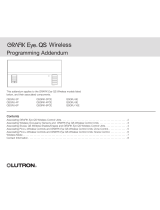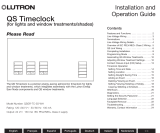
®
GRAFIK Eye® QS Installation and Operation Guide 2
Contents
Features and Functions of the
GRAFIK Eye® QS. . . . . . . . . . . . . . . . . . . . . . . . . . . . . . . 3
Wiring the GRAFIK Eye® QS
Overview of Line Voltage/Mains Wiring . . . . . . . . . 4
Line Voltage Wiring Details. . . . . . . . . . . . . . . . . . . 5
Overview of PELV (Class 2: USA) Wiring . . . . . . . . 7
QS Link Control Wiring Details. . . . . . . . . . . . . . . . 8
QS Link Control Wiring
and Terminal Connection Example . . . . . . . . . . . 9
Powering More Than 3 Wallstations . . . . . . . . . . 10
Completing Installation of the
GRAFIK Eye® QS. . . . . . . . . . . . . . . . . . . . . . . 11
General Functionality . . . . . . . . . . . . . . . . . . . 12
Pre-Programmed Button Functionality . . . . . 13
Zone Button Operation
Zone LED Displays for % of Lighting Levels . . . . 14
Programming Mode
Entering and Exiting Programming Mode . . . . . . 15
Navigating Menus in Programming Mode . . . . . . 15
Wireless Mode. . . . . . . . . . . . . . . . . . . . . . . . . 16
FCC Information . . . . . . . . . . . . . . . . . . . . . . . . . . 16
Zone Setup
Assign Load Types . . . . . . . . . . . . . . . . . . . . . . . . 17
Assign Non-Dim Load Type . . . . . . . . . . . . . . . . . 17
Setting Load Types . . . . . . . . . . . . . . . . . . . . . . . . 18
Set High End or Low End Trim. . . . . . . . . . . . . . . 19
Set Minimum Level (optional) . . . . . . . . . . . . . . . . 19
Label a Zone (optional) . . . . . . . . . . . . . . . . . . . . . 20
Contact Closure Input (CCI) Mode Setup . . . 21
Associating Wireless Occupancy Sensors
and GRAFIK Eye® QS Wireless
Control Units . . . . . . . . . . . . . . . . . . . . . . . . . 22
Occupancy Sensor Setup
Mode Assignment . . . . . . . . . . . . . . . . . . . . . . . . . 23
Scene Mode . . . . . . . . . . . . . . . . . . . . . . . . . . . . . 24
Zone Mode . . . . . . . . . . . . . . . . . . . . . . . . . . . . . . 25
Label an Occupancy Sensor (optional) . . . . . . . . 26
Configure Occupancy Sensor Settings . . . . . . . . 27
Associating Wireless Daylight Sensors
and GRAFIK Eye® QS Wireless
Control Units . . . . . . . . . . . . . . . . . . . . . . . . . 28
Daylight Sensor Setup
Assign Sensors . . . . . . . . . . . . . . . . . . . . . . . . . . . 29
Label a Daylight Sensor (optional) . . . . . . . . . . . . 30
Scene Setup
Set Zone Levels, Fade Rates,
and Shade Group Actions . . . . . . . . . . . . . . . . . 31
Label a Scene (optional) . . . . . . . . . . . . . . . . . . . . 32
Enable/Disable Daylighting per Scene. . . . . . . . . 32
Set Save Mode
Save Modes. . . . . . . . . . . . . . . . . . . . . . . . . . . . . . 33
Quick Scene Programming
Save by OK Mode . . . . . . . . . . . . . . . . . . . . . . . . . 34
Timeclock Operation
Set Time and Date . . . . . . . . . . . . . . . . . . . . . . . . 35
Set Location . . . . . . . . . . . . . . . . . . . . . . . . . . . . . 36
Set Daylight Saving Time . . . . . . . . . . . . . . . . . . . 36
Add an Event . . . . . . . . . . . . . . . . . . . . . . . . . . . . . 37
Delete an Event . . . . . . . . . . . . . . . . . . . . . . . . . . . 38
View an Event . . . . . . . . . . . . . . . . . . . . . . . . . . . . 38
Set a Holiday . . . . . . . . . . . . . . . . . . . . . . . . . . . . . 39
View a Holiday . . . . . . . . . . . . . . . . . . . . . . . . . . . . 39
Delete a Holiday . . . . . . . . . . . . . . . . . . . . . . . . . . 39
Copy a Schedule . . . . . . . . . . . . . . . . . . . . . . . . . . 40
Delete a Schedule . . . . . . . . . . . . . . . . . . . . . . . . . 40
Afterhours Mode . . . . . . . . . . . . . . . . . . . . . . . . . . 41
Set Up Afterhours Mode . . . . . . . . . . . . . . . . . . . . 42
End Afterhours Mode . . . . . . . . . . . . . . . . . . . . . . 42
Associating Pico® Wireless Controls and
GRAFIK Eye® QS Wireless Control Units
To use the Pico Wireless Control as a
Scene Controller . . . . . . . . . . . . . . . . . . . . . . . . . 43
To use the Pico Wireless Control as a
Zone Controller . . . . . . . . . . . . . . . . . . . . . . . . . . 44
Associating Sivoia® QS Shades/Drapes
and GRAFIK Eye® QS Control Units . . . . . . 45
Adjusting Shade Settings
Setting Limits. . . . . . . . . . . . . . . . . . . . . . . . . . . . . 46
Preset Adjustment: Simple Method . . . . . . . . . . . 47
Preset Adjustment: Advanced Method . . . . . . . . 47
Name a Group of Shades . . . . . . . . . . . . . . . . . . . 48
Associating Multiple GRAFIK Eye® QS
Control Units . . . . . . . . . . . . . . . . . . . . . . . . . 49
Diagnostics and Special Settings
Enable/Disable Timeclock . . . . . . . . . . . . . . . . . . 50
Enable/Disable IR Receiver . . . . . . . . . . . . . . . . . 50
Enable/Disable Backlighting. . . . . . . . . . . . . . . . . 50
Diagnostics . . . . . . . . . . . . . . . . . . . . . . . . . . . . . . 50
Activate System Accessories . . . . . . . . . . . . . 51
Faceplate Removal . . . . . . . . . . . . . . . . . . . . . 51
Language Selection . . . . . . . . . . . . . . . . . . . . 51
Troubleshooting . . . . . . . . . . . . . . . . . . . . . . . 52
Troubleshooting: Wireless Functions. . . . . . . 53
Troubleshooting: Shade Functions . . . . . . . . 54
Warranty . . . . . . . . . . . . . . . . . . . . . . . . . . . . . 55
Contact Information . . . . . . . . . . . . . . . . . . . . 55





























